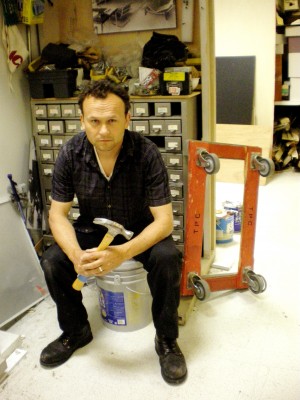Marjorie Phillips painted Night Baseball in 1951, capturing an all American moment that was also so D.C.–the Washington Senators playing the Yankees at Griffith Stadium, a historic ballpark that stood at Georgia Avenue and W Street, NW, until 1965. This summer, the painting joins a selection of work by some 80 artists to tell the story of art in the district beginning in the 1940s. Washington Art Matters: 1940s-1980s is on view at American University’s Katzen Art Center through August 11. When you visit, you’ll recognize other works from the Phillips–Gene Davis’s Black Flowers (1952) and Augustus Vincent Tack’s Time and Timelessness (The Spirit of Creation) (between 1943 and 1944). The exhibition is accompanied by a free lecture series, co-sponsored by Art Dealers Association of Greater Washington, which aims to provide attendees with the skills they need to be art collectors themselves.
Tag Archives: Washington
The Artist Sees Differently: Alec MacKaye
Alec MacKaye, preparator
How did you learn about the Phillips?
This is a funny question [for a Washington, D.C. native]! Like asking how did one first hear about the White House or the cherry blossoms or Neil Armstrong. I heard about The Phillips Collection because it holds a place in United States cultural history, in D.C. history, and in the art world. It may not be among the loudest of voices in the museum-iverse, but some things don’t need a brass band or sky writing to announce their presence.
Not to mention, being a fifth generation Washingtonian, I suppose I learned of the Phillips before I was born – my mother’s next-door neighbor and sometimes painting instructor was a man named Edgar Hewitt Nye. Two of his paintings are held in The Phillips Collection (and many more in the MacKaye Collection!), and his wife, Elizabeth Quackenbush Nye, was my parents’ English teacher at Sidwell Friends. So you see, it would be difficult to pinpoint exactly when I first heard of The Phillips Collection – it was part of me before I knew it.
You’re a musician, a writer, and an artist – do you feel you are inspired by the Phillips art?
Yes – and then more broadly, through it. There are a few certain objects that float before me when I am thinking of something, usually a Alfred Pinkham Ryder or a Philip Guston or a John Marin, and more than that, working here affords me the opportunity to see more than just what we hold. The small Hiroshige show we had a few years back changed the way I dream.
What do you listen to as you’re making art?
Silence, unless I want or need something to force my hand – then its Library of Congress field recordings or punk rock or dub reggae.
Who’s your favorite artist in the collection?
I won’t tell which ones I usually say I like most, names that most people recognize – instead I will give a couple of names that should send folks to the “search” function on our website, since they likely haven’t seen them on our walls: Henry Gershwin, Joseph Solman. I like these two not necessarily for their high finish or classic theme but more for their direct delivery. Continue reading


